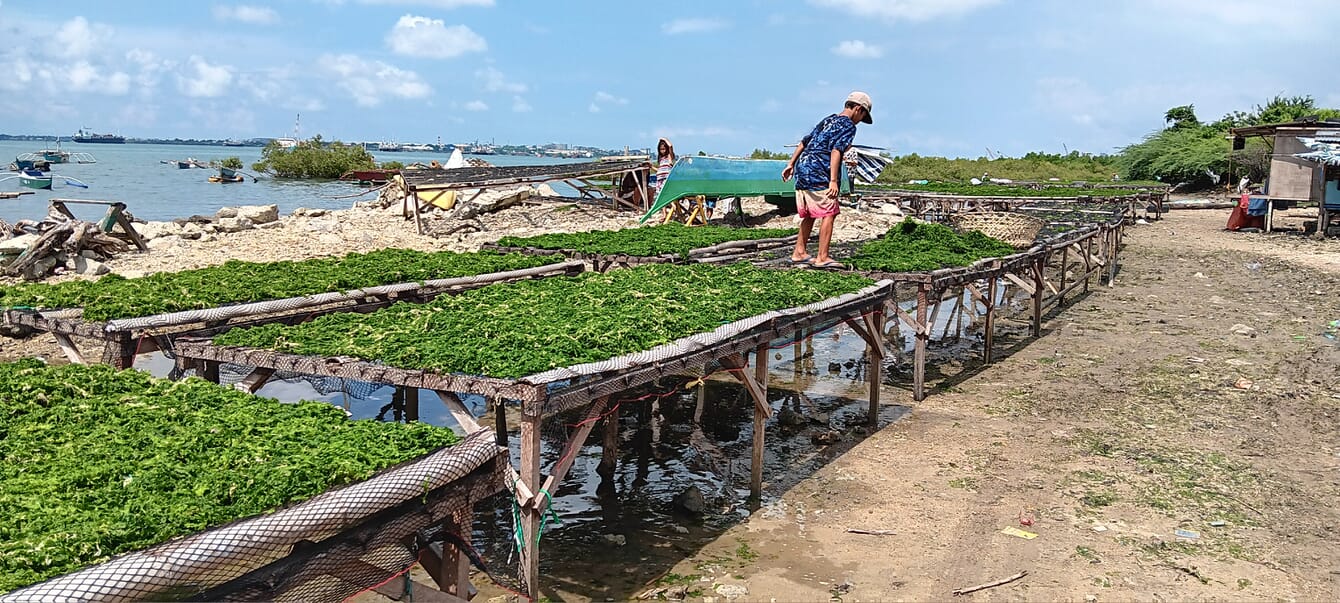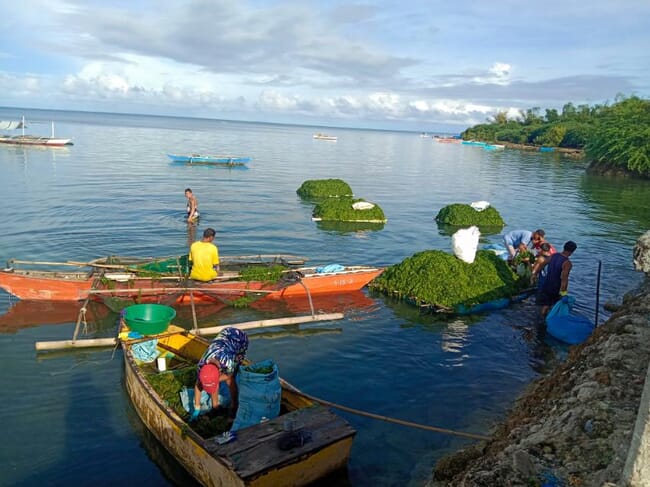
© Royal Algaculture
In the 1970s, the Philippines pioneered tropical seaweed cultivation. Just two red seaweed species were farmed, to be transformed into carrageenan: cottonii (Kappaphycus alvarezii) and spinosum (Eucheuma denticulatum).
Seaweed volumes grew profusely in those first few decades, to eventually provide work for some 200,000 households. In recent years, however, Filipino sea farmers have struggled to keep up production. The reasons are varied: warming waters, super-typhoons, competition from Indonesia, strong price fluctuations, a lack of quality seedstock and waning support from the government are just some of the issues the sector is facing.
Last year, in particular, was a watershed moment. Like elsewhere, the pandemic set off a bullwhip effect through the supply chain: prices for dried cottonii rose to a historical high of $3,000 per tonne in 2022, before falling off a cliff in 2023 to less than $1,000 per tonne. While farmers could simply stop growing seaweed under these uneconomical prices, it was the seaweed traders who were left holding the bag.
Christian Albaño of Royal Algaculture, based in Cebu, was one of them.
“The post-Covid economic slump in China really affected us. We had been relying on the trade in cottonii and spinosum for more than 20 years, but with a warehouse full of expensive stock and a drop-off in demand, we needed solutions quickly. Ulva came to the rescue,” he explains.
New markets
Trading Room’s Obi Roco was the first to seize the Ulva opportunity in the Philippines when she started exporting raw dried seaweeds to Europe, in 2012.
To this day, Trading Room continues to ship raw seaweeds, but the company has expanded its focus to value addition through its Eco Life brand. Their factory in Luzon now produces its own animal and aquafeed additives, with several more R&D projects ongoing on cosmetics and biostimulants from an assortment of Ulva species. Eco Life is now expanding its factory, driven by strong sales growth in Europe and Asia.
While startups in Europe and Israel have plans to use Ulva for anything from plastics to electricity to skin care to drop-in protein, the main applications are currently as animal feed additives in Europe, and abalone feed in China.
Food is another market where insiders see growing prospects. Alvin Monotilla, now assistant professor at the University of San Carlos in Cebu, saw the potential first-hand as a PhD student in Japan.
“Fried snacks and crisps are a great application for Ulva. The taste really pops,” he reflects.
Cultivation to fill supply gaps: the Japanese experience
In Japan, recent years have seen poor harvests of Ulva (known as “aonori” in Japanese). This has forced companies who would previously buy from suppliers to invest in onshore aquaculture themselves. For instance, in 2020, Mishima Foods was forced to suspend sales of its aonori product, due to record low harvests of Ulva prolifera in Japan. The company then built a new land-based facility in Hiroshima Prefecture and resumed selling the product in 2021.
Professor Monotilla is now trying to bring the knowledge he gathered in Japan – where he was a researcher for a Japanese Ulva cultivator, Sea Vegetable Co – to the Philippines. Through his startup Uptech, he has patented a new, wedge-shaped cultivation tank to optimise growth rates.
However, the widespread adoption of his system remains an uphill battle, as he explains: “The funding environment in the Philippines is challenging, to say the least, both from a business and an academic perspective. On top of that, although wild harvesting comes with its own set of difficulties, we have yet to see the supply crunch here that Japan has faced, so the incentive to invest in expensive land-based cultivation just isn’t there.”

The challenges
However, given the challenges surrounding the supply of wild Ulva, there might yet be an appetite for tank-based sea lettuce farming, as Obi Rocco explains: “With wild harvests, there is always an element of unpredictability. You need supply year-round. So do you have different places where the bloom is happening at different times; is the wind blowing in the right direction? We have identified several areas in the Philippines, but seasonality has become much less predictable recently, perhaps because of climate change.
“The Philippines, as an archipelago, is also very heavy on logistics. So a lot of the expense is really on the movement. So even if Ulva is present around this island, is it still cost-effective to bring it to the factory? Especially when talking about animal feed, which is a very price-sensitive market.”
For Christian Albaño, instead, the biggest challenge is to find new markets. While China’s abalone market is deep, the pandemic made him wary of relying too much on his giant neighbour.
As he explains: “There is interest beyond feed – for food products – from the US and Europe as well as Asia. We hope to grow those markets.”

© Eco Life Harvest
Albaño has identified another upside to the new species.
“What we really love about Ulva is how we are bringing income to the urban poor. Seaweed farming tends to happen in rural settings. Ulva instead often blossoms near cities, where it reacts to the extra nutrients going into the water. With Ulva, we have managed to create jobs for dozens of slum dwellers who generally have very limited opportunities. That’s been an unexpected benefit that we want to expand on.”
What does the future hold for the species? Stefan Kraan, chief scientific officer at The Seaweed Company, kickstarted the business in the Philippines through his early work on seaweed-based feed additives.
In his view: ”Ulva will be here to stay. With some applications already proven and several big research projects such as the EU COST Action Ulva Wheat of the Sea focusing on new food applications, it is just a matter of time until it becomes an everyday part of our lives, from feed to food to helping to fuel the protein transition.”

© Royal Algaculture




